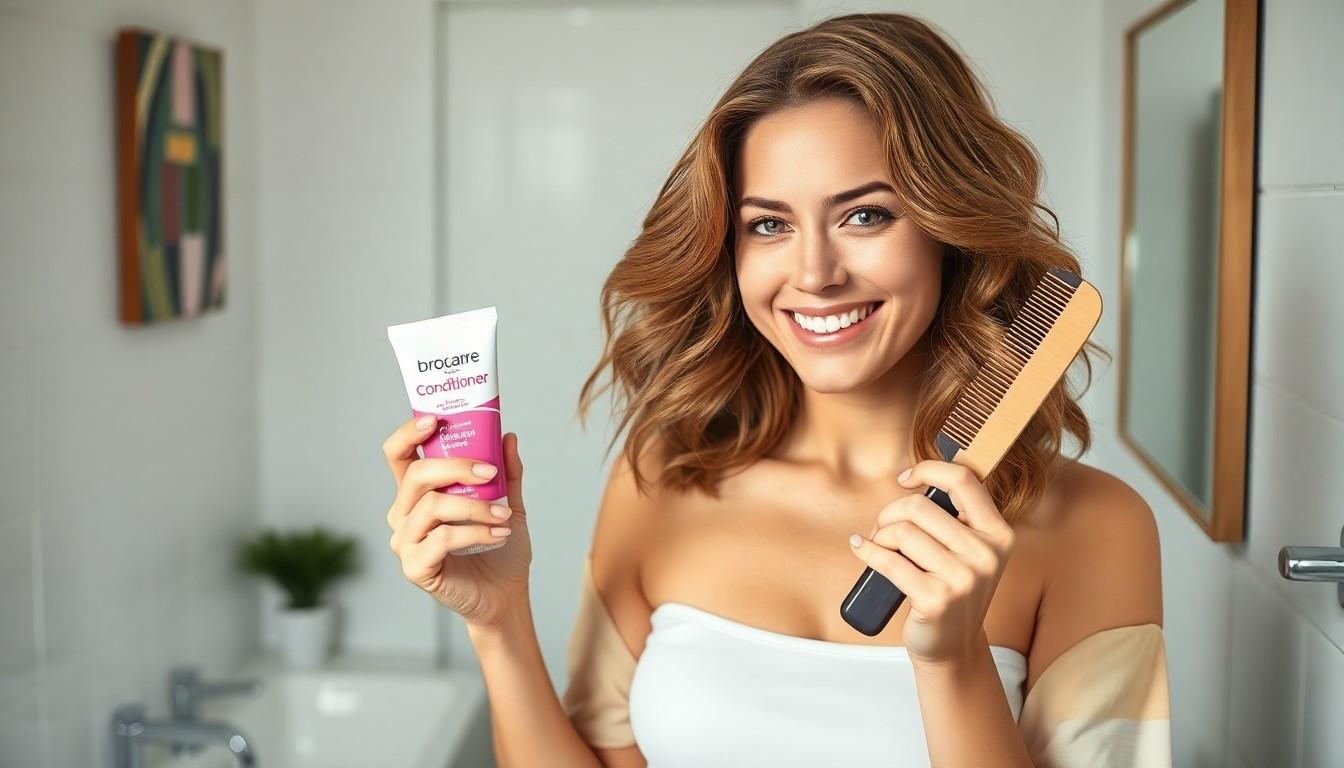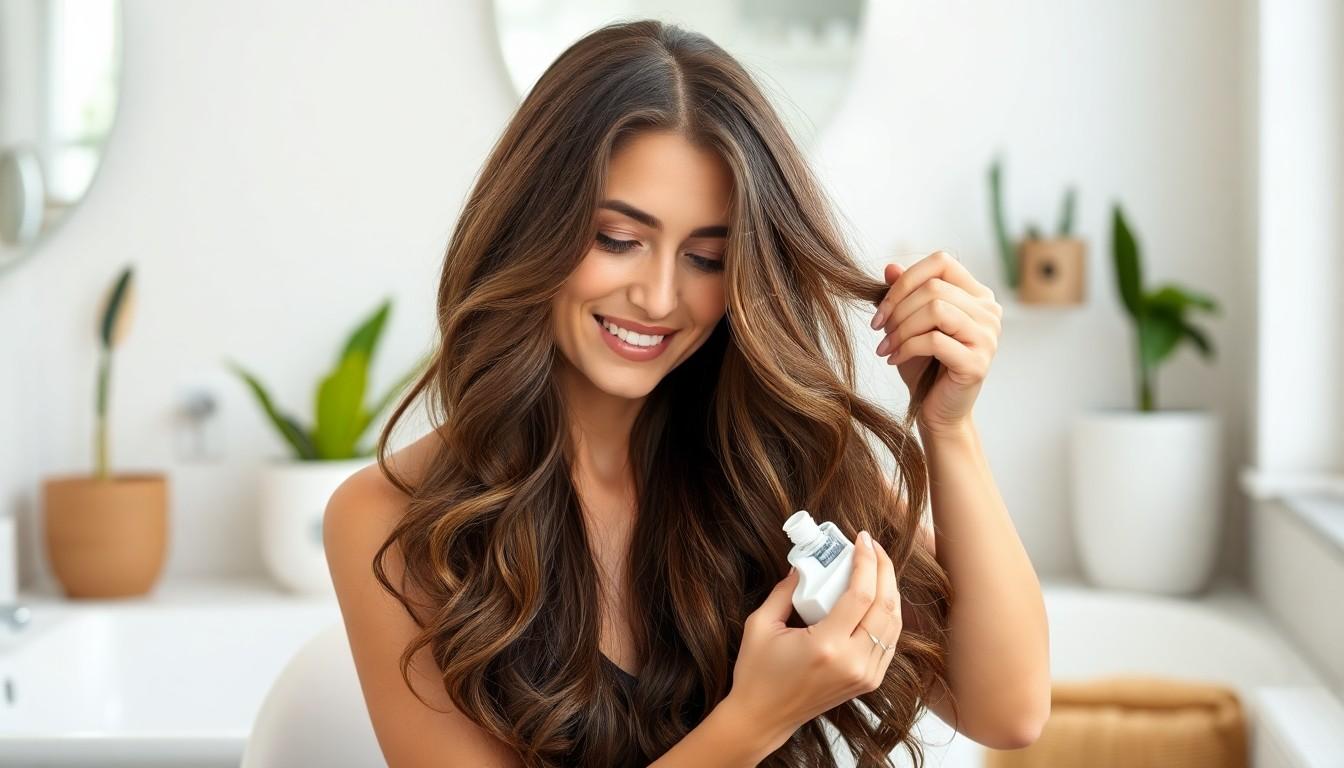Struggling with dry, damaged hair? We’ve all been there. Deep conditioning is the secret weapon your hair routine might be missing—a groundbreaking treatment that goes beyond regular conditioners to restore moisture, strength, and shine.
In this guide, we’ll walk you through everything you need to know about deep conditioning treatments. Whether you’re dealing with heat damage, color-treated locks, or naturally dry hair, we’ll show you how to bring your tresses back to life. With the right techniques and products, you’ll transform your hair from brittle and lifeless to soft and manageable.
Understanding Deep Conditioning: What It Is and Why Your Hair Needs It
Deep conditioning is an intensive hair treatment that penetrates the hair shaft to restore moisture, rebuild strength, and improve elasticity. Unlike regular conditioners that work primarily on the surface, deep conditioners contain concentrated ingredients that work beneath the cuticle layer of your hair. These specialized treatments typically feature higher concentrations of moisturizing oils, proteins, and nutrients designed to address exact hair concerns.
Your hair needs deep conditioning because daily environmental stressors like heat styling, chemical treatments, and sun exposure gradually strip away natural oils and proteins. Regular shampoos and conditioners simply can’t provide the level of repair that damaged hair requires. Through deep conditioning, we’re able to replenish these essential elements, preventing breakage and split ends while promoting healthier growth.
Hair that lacks proper conditioning often appears dull, feels brittle, and becomes increasingly difficult to manage. The right deep conditioning routine transforms your hair by improving texture, improving shine, and making styling significantly easier. For those with curly or textured hair, deep conditioning is particularly crucial as these hair types tend to be naturally drier and more prone to damage.
Most hair care professionals recommend incorporating deep conditioning treatments into your routine at least once or twice a month, though frequency varies based on your hair’s exact needs. Hair that’s been bleached, colored, or regularly heat-styled benefits from weekly deep conditioning sessions to counteract ongoing damage and maintain optimal hair health.
Identifying Your Hair Type: Customizing Your Deep Conditioning Routine

Understanding your exact hair type is the first step to creating an effective deep conditioning routine. We’ll explore how to tailor your approach based on whether you have fine, thick, or curly hair to maximize the benefits of each treatment.
Fine Hair Conditioning Strategies
Fine hair requires a gentle approach to deep conditioning to avoid weighing it down. Look for lightweight formulations specifically designed for fine hair that provide moisture without excessive heaviness. Apply your deep conditioner from the mid-shaft to the ends only, keeping the product away from your scalp to prevent unwanted oiliness and flat roots. Timing matters significantly with fine hair—limit your conditioning sessions to 15-20 minutes to prevent over-moisturizing that could lead to limp strands. Use a wide-tooth comb or detangling brush while the conditioner is in your hair to ensure even distribution and gently remove tangles without causing breakage.
Thick Hair Deep Treatment Methods
Thick hair typically needs more intensive moisturizing treatments to penetrate the dense strands effectively. Choose rich, creamy deep conditioners formulated with ingredients that can properly hydrate thicker hair textures. Apply your conditioning treatment generously from roots to ends, ensuring complete coverage throughout all layers of your hair. Allow the product to remain on your hair for 30 minutes to an hour, giving it adequate time to fully absorb into the thicker strands. Products containing nourishing ingredients like coconut oil, shea butter, or argan oil work particularly well for thick hair by providing the deep hydration and nourishment needed to maintain softness and manageability.
Curly Hair Deep Conditioning Essentials
Curly hair demands extra attention due to its natural tendency toward dryness and fragility. Select deep conditioners specifically formulated for curly textures, focusing on products that offer intense hydration and anti-breakage benefits. Apply your conditioner liberally throughout your curls, paying special attention to the ends which typically experience the most dryness. Leave the treatment on for at least 30 minutes to an hour—some curly hair specialists even recommend overnight treatments with a shower cap for maximum absorption. Gently detangle your curls using either a wide-tooth comb or your fingers while the conditioner is still in your hair to minimize breakage and distribute the product evenly. Replace traditional towel-drying with a microfiber towel or old t-shirt when blotting excess water to reduce friction that can disrupt your curl pattern and cause breakage.
Selecting the Right Deep Conditioner for Your Hair Concerns

Choosing the appropriate deep conditioner can make all the difference in addressing your exact hair needs. Each hair type and condition requires a customized approach to achieve the best results.
Moisture-Focused Conditioners for Dry Hair
Dry hair demands deep conditioners rich in moisturizing ingredients that can thoroughly hydrate each strand. Apply these moisture-focused conditioners from roots to ends, as dry hair benefits from comprehensive hydration throughout the entire length. Distributing the product evenly is essential, so we recommend combing it through with your fingers or a wide tooth comb. Focus extra attention on the ends of your hair where dryness typically manifests most severely. These specialized formulations work to replenish lost moisture and restore flexibility to brittle strands, transforming parched locks into soft, manageable hair.
Protein Treatments for Damaged Hair
Damaged hair requires protein-based deep conditioners to rebuild strength and repair structural weaknesses. Consider applying a regular conditioner before your protein treatment to help lock in both moisture and protein benefits for maximum effectiveness. Concentrate the application from mid-shaft to ends where damage is most noticeable and needs the most attention. Protein treatments work by filling in gaps in the hair cuticle, reinforcing weak spots and preventing further breakage. These specialized formulas are particularly beneficial for hair that’s been compromised by heat styling, chemical treatments, or environmental stressors.
Color-Safe Options for Treated Hair
Color-treated hair needs special protection to maintain vibrancy and prevent premature fading. Look specifically for deep conditioners labeled as “color-safe” or “color-protecting” to preserve your investment in color services. Apply these specialized formulations evenly throughout your hair, ensuring complete coverage by combing the product through thoroughly. Leave the conditioner on for the recommended 20-30 minutes to allow the protective ingredients to fully penetrate and work their magic. Color-safe deep conditioners typically contain UV filters and antioxidants that shield hair from environmental factors that can cause color to deteriorate while simultaneously providing the deep hydration needed to keep colored hair looking healthy and vibrant.
The Step-by-Step Deep Conditioning Process

Pre-Conditioning Preparation
Setting up your hair properly before deep conditioning is crucial for maximum benefits. Follow these important steps to prepare your hair:
- Cleanse your hair thoroughly with your regular shampoo to remove dirt and product buildup, especially if your scalp is oily. Skip shampooing if your scalp isn’t dirty to avoid stripping natural oils.
- Apply regular conditioner first if your hair is severely damaged. This extra step provides an additional layer of moisture before the deep treatment.
- Remove all tangles by gently combing through your hair with your fingers or a wide-tooth comb. Detangling ensures the deep conditioner distributes evenly throughout your strands.
Application Techniques for Maximum Benefits
Proper application makes all the difference in how effectively your deep conditioner works. Try these techniques for optimal results:
- Start from the ends and work upward when applying your deep conditioning mask. Focus on the ends first since they’re typically the most damaged and driest part of your hair.
- Adjust application based on your hair type – those with dry hair or tight curls should apply conditioner close to or at the roots, while people with oilier hair should concentrate on mid-lengths to ends.
- Distribute product evenly throughout your hair using your fingers or a wide-tooth comb. This ensures complete coverage and prevents patchy results.
- Cover your hair with a shower cap after application to trap heat and help the conditioner penetrate the hair shaft more effectively.
Duration of Application
Timing plays a critical role in achieving the best results from your deep conditioning treatment:
- Check product instructions carefully as most deep conditioners work best when left on for 20-30 minutes. Some formulas may require different timing based on their exact ingredients.
- Consider overnight treatment for extremely dry or damaged hair. Apply the conditioner, cover with a shower cap, and rinse in the morning for intensive repair.
Heat Application Methods to Enhance Penetration
Heat dramatically improves how well your deep conditioner works by opening the hair cuticle. Here are effective ways to incorporate heat:
- Use a hair steamer to apply consistent, gentle heat that helps conditioner penetrate deeper into the hair shaft. Steamers are particularly effective for low-porosity hair.
- Wrap your head in a warm towel if you don’t have specialized equipment. Heat the towel in the dryer or with warm water, then wrap it around your shower-capped head.
- Apply low heat from a blow dryer for 5-10 minutes to enhance penetration. Keep the dryer moving to avoid overheating any one section.
Final Steps
Properly finishing your deep conditioning treatment ensures you lock in all the benefits:
- Rinse thoroughly with cool water to remove all product residue while sealing the cuticle. Cool water helps close the hair shaft and lock in moisture.
- Apply your regular styling products after towel-drying your hair. Your hair will be more receptive to styling products after deep conditioning.
DIY Deep Conditioning Recipes Using Natural Ingredients

Looking to deep condition your hair without spending a fortune on commercial products? We’ve compiled some effective DIY recipes using ingredients you likely already have in your kitchen.
Avocado and Honey Mask for Dry Hair
The combination of avocado and honey creates a deeply nourishing treatment for parched locks. Take one ripe avocado and mash it thoroughly before mixing in 1-2 tablespoons of honey until you achieve a smooth consistency. Apply this mixture generously to your hair, focusing particularly on the mid-shaft to ends where dryness is most common. Cover your hair with a plastic cap and let the mask work its magic for 20-30 minutes. Rinse thoroughly with cool water to seal the cuticle. Avocado provides essential moisture and nutrients to your hair, while honey acts as a natural humectant that locks in hydration and adds a beautiful shine.
Coconut Oil Treatment for Damaged Ends
Coconut oil stands as one of the most effective natural remedies for repairing damaged hair ends. Warm a generous amount of coconut oil by placing the container in warm water or gently heating it until it liquefies. Apply the warmed oil thoroughly to your ends, working your way up to mid-shaft if needed. Massage the oil into your hair to ensure complete coverage and maximum absorption. Leave this treatment on for 30 minutes to an hour before shampooing as usual. The rich fatty acids in coconut oil penetrate the hair shaft, repairing damage from the inside out and restoring moisture to brittle ends.
Yogurt and Banana Mask for Frizzy Hair
Taming frizz becomes simple with this powerful yogurt and banana combination. Mash one ripe banana until completely smooth (strain if necessary to remove lumps) and mix with 2 tablespoons of plain yogurt. Apply this mixture evenly throughout your hair, ensuring all frizzy sections receive adequate coverage. Place a plastic cap over your hair and allow the mask to sit for 20-30 minutes before rinsing with cool water. Yogurt contains proteins that help smooth the hair cuticle and reduce frizz significantly, while banana adds softness and moisture. Regular application of this mask will progressively improve your hair’s texture and manageability, making it an excellent solution for those struggling with persistent frizz.
Post-Deep Conditioning Care: Lock in the Benefits

Gentle Drying Techniques
After rinsing out your deep conditioner, resist the urge to roughly dry your hair. Instead, gently pat your hair with a microfiber towel or an old cotton t-shirt to remove excess moisture. This gentle approach helps preserve the benefits of your deep conditioning treatment by preventing frizz and breakage. Your hair is particularly vulnerable when wet, so treating it with care at this stage is essential for maintaining those newly restored moisture levels.
Cool Water Rinse
Always finish your deep conditioning session with cool water. This important step helps seal the hair cuticle, locking in all the nourishing ingredients you’ve just applied. Hot water can strip away the conditioning agents and leave your hair vulnerable, while cool water creates a smooth surface that reflects light better for added shine. The temperature contrast might feel jarring at first, but your hair will thank you with improved luster and longer-lasting hydration.
Lock in Moisture with Styling Products
Apply your regular styling products while your hair is still damp to trap the moisture from your deep conditioning treatment. Leave-in conditioners, hair oils, or creams can form a protective barrier around your freshly conditioned strands. These products work synergistically with your deep conditioner to extend its benefits throughout the week. Focus application on the mid-lengths and ends where dryness typically occurs most.
Air Dry When Possible
Whenever possible, allow your freshly deep conditioned hair to air dry rather than using heat styling tools. Heat can quickly undo the moisture-restoring benefits of your treatment. If you must use heat styling, apply a heat protectant first and use the lowest effective temperature setting. This approach helps maintain the integrity of your hair shaft and preserves the conditioning benefits for longer periods.
Nighttime Protection
Protect your deep conditioned hair while you sleep by using a silk or satin pillowcase. These smooth materials create less friction than cotton, helping to maintain moisture levels and prevent frizz. For even more protection, consider loosely braiding your hair or wearing a silk bonnet at night. These nighttime habits extend the life of your deep conditioning treatment by minimizing moisture loss and reducing mechanical damage.
Common Deep Conditioning Mistakes to Avoid

Not Following Product Instructions
Deep conditioning products come with exact guidelines for a reason. Every formulation has unique ingredients and concentration levels that work best when applied according to the manufacturer’s recommendations. Reading and following the instructions on the packaging ensures you get the maximum benefit from your treatment. Product directions typically specify important details like application methods, duration, and whether heat should be used to enhance the conditioning effect.
Not Combing Through
Failing to distribute deep conditioner evenly throughout your hair significantly reduces its effectiveness. Many people simply slather the product on without ensuring complete coverage. Using your fingers or a wide tooth comb to work the conditioner through your strands is crucial for consistent results. Starting at the ends and working your way up helps prevent tangles while guaranteeing that every strand receives nourishing treatment.
Leaving It On Too Little Time
Rushing your deep conditioning session won’t deliver the desired results. The conditioning agents need adequate time to penetrate the hair shaft and work their magic. Most deep conditioners require 20-30 minutes to effectively moisturize and repair damaged hair. Cutting this time short means your hair won’t absorb all the beneficial ingredients, leaving you with subpar results even though using quality products.
Using Too Much or Too Little Product
Finding the right amount of deep conditioner is essential for effective treatment. Applying excessive product doesn’t necessarily yield better results and can be wasteful. Conversely, using too little product may leave sections of your hair under-conditioned. The appropriate amount typically depends on your hair length, thickness, and porosity – generally, enough to coat all strands without product dripping off your hair.
Not Rinsing Thoroughly
Residual deep conditioner left in your hair can cause more harm than good. Incomplete rinsing often leads to product buildup that weighs down your hair and makes it look greasy. Taking the extra time to rinse thoroughly with cool water not only removes all product residue but also helps seal moisture into the hair shaft, leaving your locks clean, light, and properly conditioned.
Creating a Regular Deep Conditioning Schedule for Healthier Hair

Preparing Your Hair
Deep conditioning starts with proper hair preparation to maximize effectiveness. We recommend beginning with your usual shampoo to remove any dirt or product buildup that might prevent the conditioner from penetrating effectively. Rinsing your hair with lukewarm water creates the ideal foundation for your treatment by opening the hair cuticles without causing irritation to your scalp.
Applying the Deep Conditioner
Proper application technique ensures your hair reaps all the benefits of deep conditioning. For most hair types, applying conditioner after shampooing delivers optimal results, though some exact hair types might benefit from pre-shampoo conditioning. Focus on applying a generous amount from mid-shaft to ends if you have oilier hair, while those with dry or damaged locks should apply from roots to ends for comprehensive nourishment.
Distribution and Combining
Even distribution is crucial for effective deep conditioning results. Use your fingers or a wide-tooth comb to work the product thoroughly through your strands, ensuring no section is left untreated. This methodical approach not only helps detangle your hair but also guarantees the conditioning agents can penetrate each strand effectively for uniform treatment benefits.
Leaving it On
Unlike regular conditioners that only need 1-2 minutes, deep conditioners require important time to work their magic. Allow the product to remain on your hair for 15-30 minutes at minimum for standard treatments. For particularly damaged or dry hair, extending the treatment time to several hours or even overnight with a shower cap can provide intense restoration benefits.
Rinsing and Follow-Up
Thorough rinsing prevents product buildup that could weigh down your freshly conditioned hair. Use lukewarm water to remove all traces of the deep conditioner, ensuring your hair feels clean but still moisturized. Following up with a quick rinse-out conditioner can help seal in the benefits of your deep conditioning treatment while adding an extra layer of smoothness.
Frequency of Deep Conditioning
Establishing the right frequency depends largely on your exact hair needs and styling habits. Weekly deep conditioning works well for most hair types as a general guideline. Very dry or damaged hair benefits from more frequent treatments, approximately every 3-4 days, while oilier hair types should space treatments further apart, roughly every 10-14 days, to prevent heaviness or buildup.
Additional Tips
Deep conditioners offer superior benefits compared to regular conditioners due to their ability to penetrate the hair strand. These specialized formulas effectively detangle, reduce frizz, enhance shine, and improve smoothness for longer periods. Finding the perfect balance for your exact hair needs prevents potential product buildup while still providing maximum nourishment and protection against environmental stressors.
Conclusion
Deep conditioning isn’t just another step in your hair care routine—it’s a groundbreaking treatment that can revitalize your locks from the inside out. By understanding your hair’s unique needs and following the techniques we’ve shared you’ll see important improvements in moisture strength and manageability.
Remember that consistency is key. Whether you’re using store-bought treatments or whipping up DIY masks your hair will thank you for the regular nourishment. Don’t forget that proper application technique and timing make all the difference in maximizing benefits.
Start incorporating deep conditioning into your regular hair care schedule and watch as your hair becomes healthier more vibrant and easier to style. Your journey to gorgeous locks doesn’t end here—it’s just beginning.
Frequently Asked Questions
What is deep conditioning for hair?
Deep conditioning is an intensive treatment that penetrates the hair shaft, unlike regular conditioners that only work on the surface. These specialized treatments contain concentrated ingredients designed to address specific hair concerns like dryness, damage, and breakage. They help replenish moisture and protect against environmental stressors, improving your hair’s texture, shine, and manageability.
How often should I deep condition my hair?
Most hair care professionals recommend deep conditioning treatments at least once or twice a month for general maintenance. However, frequency depends on your hair type and condition. Those with heavily treated, heat-styled, or very dry hair benefit from weekly treatments. Those with oilier hair types can space treatments further apart. Adjust based on how your hair responds.
Can I leave deep conditioner in my hair overnight?
Yes, you can leave deep conditioner in overnight for extremely dry or damaged hair. Use a shower cap or wrap your hair to protect your pillow and trap heat. However, not all products are formulated for overnight use, so check the manufacturer’s instructions first. For most hair types, 20-30 minutes is sufficient for effective treatment.
How do I deep condition fine, thin hair?
For fine hair, use lightweight formulations that won’t weigh your hair down. Apply primarily to mid-lengths and ends, avoiding the roots. Limit conditioning time to 15-20 minutes to prevent over-conditioning. Rinse thoroughly with cool water afterward. Less product is more effective—use about a quarter-sized amount depending on your hair length.
What ingredients should I look for in a deep conditioner for dry hair?
Look for deep conditioners containing humectants like honey, glycerin, and aloe vera that attract moisture. Emollients such as shea butter, argan oil, and avocado oil are excellent for sealing in hydration. Other beneficial ingredients include hyaluronic acid, panthenol (vitamin B5), and plant-based oils like jojoba or coconut oil. Avoid products with alcohol which can cause further drying.
How do I apply deep conditioner for maximum benefits?
Start with freshly washed, towel-dried hair. Section your hair for even application, focusing on mid-lengths and ends (or roots too for very dry hair). Use a wide-tooth comb to distribute the product evenly. Cover with a shower cap to trap heat, which enhances penetration. Apply gentle heat with a hooded dryer or warm towel for better absorption, then rinse thoroughly with cool water.
Can I make my own deep conditioner at home?
Absolutely! Effective DIY deep conditioners can be made using kitchen ingredients. Try an avocado and honey mask (mashed avocado, 2 tbsp honey) for dry hair, coconut oil treatment for damaged ends, or yogurt and banana mask (1 ripe banana, 3 tbsp yogurt) for frizzy hair. These natural alternatives are cost-effective and free from harsh chemicals.
How do I deep condition curly or textured hair?
Curly and textured hair requires specialized deep conditioners with intense hydration. Apply generously throughout your hair and leave on for 30-45 minutes. Use your fingers or a wide-tooth comb for gentle detangling while the conditioner is in. Consider using heat (a steamer or hooded dryer) to enhance penetration. Rinse with cool water but leave a small amount of conditioner in for added moisture.
What’s the difference between protein and moisture deep conditioners?
Protein deep conditioners contain ingredients like keratin, collagen, or amino acids that rebuild hair strength and repair structural damage. They’re best for chemically treated or damaged hair. Moisture-based conditioners focus on hydration with ingredients like oils, butters, and humectants. Balanced hair needs both—use protein treatments once a month and moisture treatments weekly or biweekly.
How should I care for my hair after deep conditioning?
After rinsing with cool water, gently pat hair dry with a microfiber towel or cotton t-shirt—never rub. Apply leave-in conditioner and styling products while hair is still damp to lock in moisture. Avoid heat styling if possible; air dry when you can. Sleep on a silk or satin pillowcase to maintain moisture levels and prevent frizz. Protect your hair at night by loosely braiding or using a protective style.







